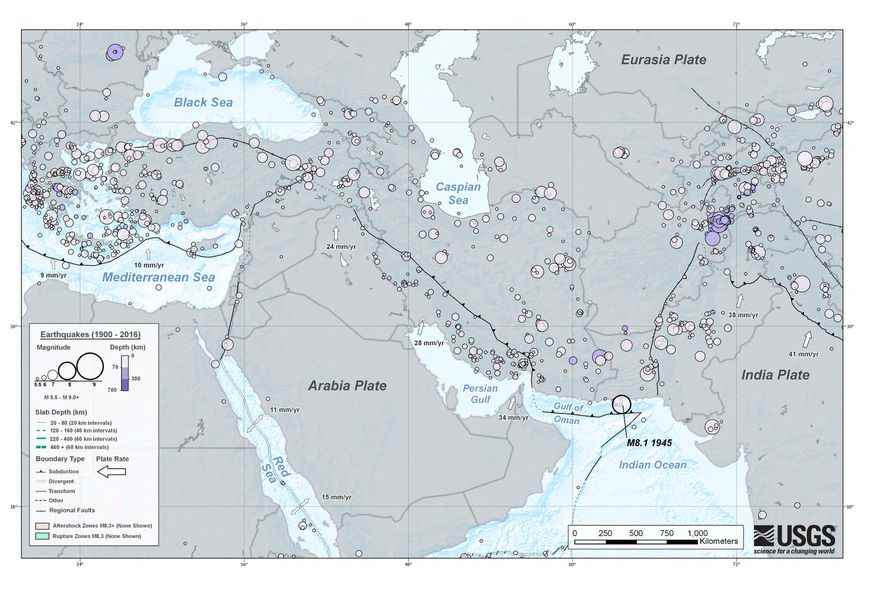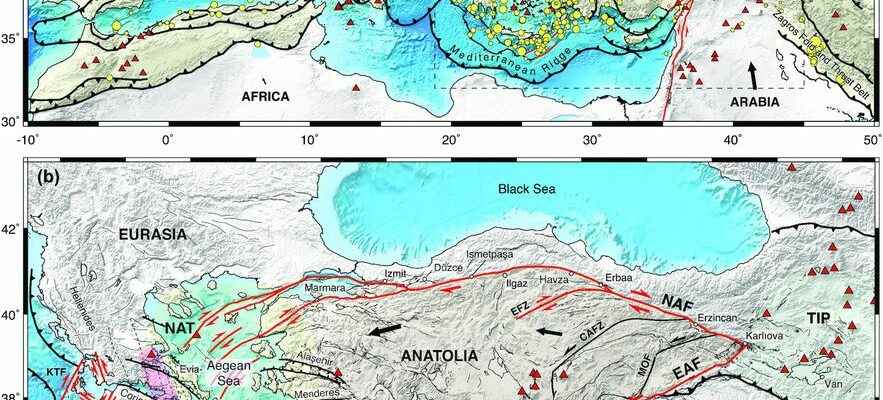A strong earthquake of magnitude 7.8 has been triggered near Pazarcik, southern Turkey, near the Syrian border, Monday, February 6 at 2:17 a.m. At 11:30 a.m., another earthquake of magnitude 7.5 occurred a few kilometers away, just when L’Express was interviewing Florent Brenguier, seismologist at the Institute of Earth Sciences. The specialist explained to us that such phenomena destabilize seismic faults and cause not only aftershocks, but also potential new earthquakes.
The provisional toll of these two events is 2,300 dead and nearly 10,000 injured. According to the Turkish public disaster management body, 2,834 buildings have collapsed, raising fears of an even heavier final toll. It could be up to eight times higher, has already warned the World Health Organization (WHO).
L’Express: Which seismic plate is at the origin of this particularly deadly earthquake?
Florent Brenguier: This is the East Anatolian Fault (EAF), which you can see in red on the diagram below. It lies between the Arabian Plate (“Arabia”), which points north, and the Anatolian Plate (“Anatolia”), which points west. In figure B, you see that the Arabian plate pushes northeast and the Anatolian plate pushes southwest. This causes stress along the EAF fault which can cause earthquakes, like the one that happened today.
Figure A shows the seismic faults around the Mediterranean Sea. Figure B zooms in on the Anatolian and Arabian faults. The two earthquakes that hit Turkey and Syria are on the EAF fault, between the “Anatolia” and “Arabia” plates.
© / S. Barbot/JR Weiss/Geophysical Journal International
The best-known fault in this region is the Great North Anatolian Fault (NAF, also in red). It caused the great earthquake of Izmit, of magnitude 7.2, in 1999, which killed more than 17,000 people. This is the largest risk area in Europe. But this time, it is the EAF fault which is at the origin of this earthquake. No earthquake of this size had been recorded on this fault for more than 100 years, so today’s event is exceptional. However, it was not completely unexpected. The second graph below provides some context, since it shows the number of earthquakes in this region. The circles designate the earthquakes since 1900, their size corresponds to the magnitude

Map showing earthquakes from 1900 to 2016 with their magnitude (the larger the circles, the higher the magnitude).
© / The United States Geological Survey (USGS)
What about the risk of aftershocks, and their potential powers?
There have already been many aftershocks since Monday morning, including one at 6.7, which is very important. It’s very powerful for a replica, it’s amazing. There could be others. The NAF fault I was telling you about has already experienced sequences of several major earthquakes: a first triggers another a little further on, etc. This is something that can happen, because when a rift moves, it destabilizes the whole area around it. We could therefore see other earthquakes along the NAF fault or the DSTF fault, which is its extension to the south. It could be tomorrow, in a month, or in five years. We can’t predict it… But it looks like a huge aftershock of magnitude 7.5 has just happened [NDLR : la secousse a été observée pendant l’entretien]. It’s very powerful for a replica, it’s amazing.
Is it an aftershock or, precisely, a new earthquake?
What we call an aftershock is normally an earthquake in a nearby area, but of lesser magnitude. There, it is an equivalent magnitude. Can we call it a replica? It’s starting to get a bit technical. Let’s say it’s a double. This is an earthquake of almost the same power as the first. It occurred on the same fault (EAF), further to the northeast. It is very rare to observe doubles like this, with such a close magnitude. We had already observed magnitude 6 aftershocks a few days after a magnitude 7 earthquake, but this is exceptional.
The area was severely affected. Rescuers are on the spot, in the rubble. The human toll is likely to explode…
According to the information I am consulting at the moment, the casualty estimates for this second earthquake are between 100 and 1,000. For the first, it was between 1,000 and 10,000. This can probably be explained by the fact that the rupture zone of this second earthquake is 80 km, against 120 km for the first, but also because it is located in a less populated area. Anyway, it is terrible for the populations concerned.
Can such a powerful earthquake destabilize the entire area and cause other earthquakes of comparable magnitude in the coming months or years?
We won’t see huge earthquakes right in the same places again for hundreds or even thousands of years, but as we have seen, other earthquakes can occur locally. The rupture zone of the first earthquake is “only” 120 km, in other words, the fault broke and was destabilized over a hundred kilometers, which caused the other earthquake, which broke over 80 km. These events did not smash the entire plate and therefore will not transform the entire tectonics of the region nor have an impact as far as Istanbul, for example. These are “only” earthquakes of magnitude 7.8 and 7.5. The Richter scale goes up to 9, which implies breaks of 1000 km.
